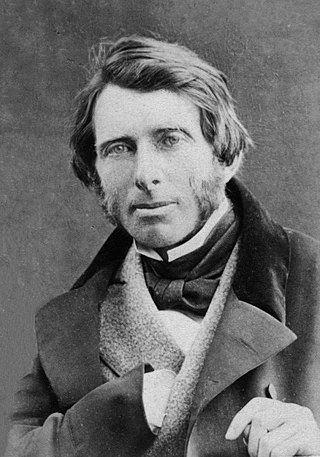
John Ruskin was an English polymath – a writer, lecturer, art historian, art critic, draughtsman and philanthropist of the Victorian era. He wrote on subjects as varied as art, architecture, political economy, education, museology, geology, botany, ornithology, literature, history, and myth.

The Lake District, also known as the Lakes or Lakeland, is a mountainous region and national park in Cumbria, North West England. It is famous for its landscape, including its lakes, coast, and the Cumbrian mountains, and for its literary associations with Beatrix Potter, John Ruskin, and the Lake Poets.

Coniston Water is a lake in the Lake District in North West England. It is the third largest by volume, after Windermere and Ullswater, and the fifth-largest by area. The lake has a length of 8.7 kilometres, a maximum width of 730 metres (800 yd), and a maximum depth of 56.1 m. Its outflow is the River Crake, which drains into Morecambe Bay via the estuary of the River Leven. The lake is in the unitary authority of Westmorland and Furness, and the ceremonial county of Cumbria.
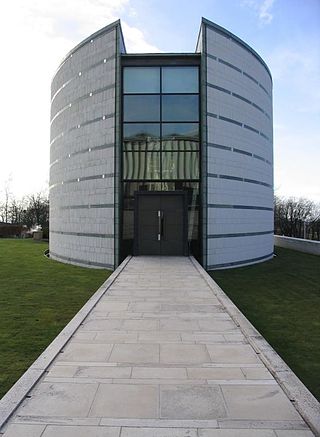
The Ruskin – Library, Museum and Research Centre is an archive, museum, and research centre at Lancaster University, in the north of England. The Director of The Ruskin is Professor Sandra Kemp. Prior to 2019, The Ruskin – Library, Museum and Research Centre was known as the Ruskin Library.

Furness is a peninsula and region of Cumbria, England. Together with the Cartmel Peninsula it forms North Lonsdale, historically an exclave of Lancashire. On 1 April 2023 it became part of the new unitary authority of Westmorland and Furness.

Coniston is a village and civil parish in the Westmorland and Furness district of Cumbria, England. In the 2001 census the parish had a population of 1,058, decreasing at the 2011 census to 928. Within the boundaries of the historic county of Lancashire, it is in the southern part of the Lake District National Park, between Coniston Water, the third longest lake in the Lake District, and Coniston Old Man.
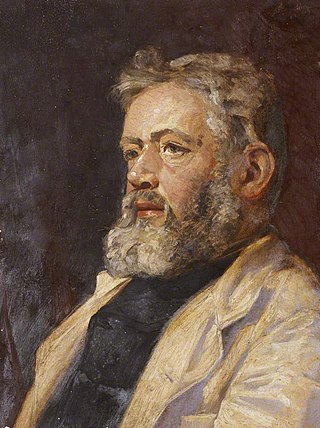
William Gershom Collingwood was an English author, artist, antiquary and professor of Fine Arts at University College, Reading. A long-term resident of Coniston, Cumbria, he was President of the Cumberland and Westmorland Antiquarian Society (1920-32) and the Lake Artists' Society.

Brantwood is a historic house museum in Cumbria, England, overlooking Coniston Water. It has been the home of a number of prominent people. The house and grounds are administered by a charitable trust, the house being a museum dedicated to John Ruskin, one of its final owners. Brantwood is recorded in the National Heritage List for England as a designated Grade II* listed building, and buildings in the grounds are also listed.
Matt Stokes is an artist and film-maker. Stokes had a residency at Grizedale Arts in 2002 during which he researched the history of rave culture in the Lake District. In 2006, he won the Beck's Futures art prize for his film Long After Tonight.
Grizedale Arts is a contemporary arts residency and commissioning agency based in Cumbria, England. Its primary artists' residency space is the former hill farm Lawson Park, sited on the edge of Grizedale Forest in the central Lake District. It also owns and runs a hybrid pub / arts centre The Farmer's Arms at Lowick, a listed building that was purchased with the support of investors and donors during the Covid19 pandemic. Grizedale Arts produces cultural projects locally, nationally and internationally with a particular focus on Japan, where a number of significant long term projects in rural communities have evolved. The focus of the organisation is on developing emerging artists and producing experimental projects that demonstrate the function of art as an everyday aspect of a worthwhile and productive life. The organisation is financially supported by Arts Council England. Adam Sutherland MBE, director since 1999, guest-curated 'The Land We Live In, The Land We Left Behind' for Hauser & Wirth Somerset in 2018, a major historic and contemporary survey of rural cultures that attracted over 40,000 visitors to the galleries in Bruton.
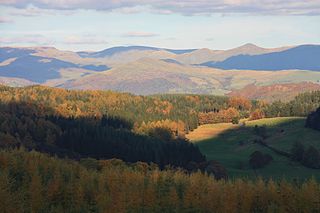
Grizedale Forest is a 24.47 km2 area of woodland in the Lake District of North West England, located to the east of Coniston Water and to the south of Hawkshead. Historically, within the county of Lancashire, it now lies in the Westmorland and Furness district of Cumbria. It is made up of a number of hills, small tarns and the settlements of Grizedale and Satterthwaite. It is owned and managed by Forestry England and is a popular tourist destination with waymarked footpaths, mountain biking, an aerial assault course, a 16-bed hostel, and a visitor centre with a children's playground, education centre, café and shop. The car-parking of Grizedale Forest Visitors Centre is situated on the site of the former Grizedale Hall where its remains can be still seen.

Bembridge School was a British independent school in Bembridge on the Isle of Wight, founded in 1919 by social reformer and Liberal MP John Howard Whitehouse, set in over 100 acres (0.40 km2) on the easternmost tip of the island. Whitehouse intended for the school, initially for boys only, to challenge the traditional concept of education, introducing subjects including woodwork, American history and modern languages, long before they became mainstream subjects in British schools.

Abbot Hall Art Gallery is an art gallery in Kendal, England. Abbot Hall was built in 1759 by Colonel George Wilson, the second son of Daniel Wilson of Dallam Tower, a large house and country estate nearby. It was built on the site of the old Abbot's Hall, roughly where the museum is today. Before the Dissolution of the Monasteries this was where the Abbot or his representative would stay when visiting from the mother house of St Mary's Abbey, York. The architect is unknown. During the early twentieth century the Grade I listed building was dilapidated and has been restored as an art gallery.

The Centre for Contemporary Arts (CCA) is an arts centre in Glasgow, Scotland. Its programme includes contemporary art exhibitions, cinema, live music, book launches, festivals, spoken word and performance. The CCA also commissions new work from artists.
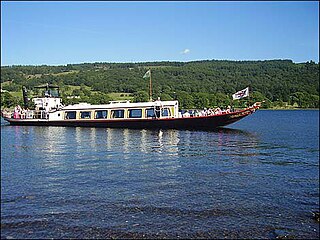
The steam yacht Gondola is a rebuilt Victorian, screw-propelled, steam-powered passenger vessel on Coniston Water, England. Originally launched in 1859, she was built for the steamer service carrying passengers from the Furness Railway and from the Coniston Railway. She was in commercial service until 1936 when she was retired, being converted to a houseboat in 1946. In 1979, by now derelict, she was given a new hull, engine, boiler and most of the superstructure. She is back in service as a passenger boat, still powered by steam and now operated by the National Trust.
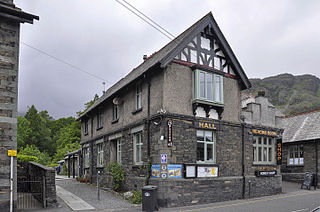
The Ruskin Museum is a small local museum in Coniston, Cumbria, northern England.

Spark Bridge is a village in the Westmorland and Furness district, in Cumbria, England, within the Lake District National Park, and within the historic boundaries of Lancashire. The former mill village is situated away from the main road on the River Crake which flows from Coniston Water to Morecambe Bay at Greenodd. The village green which is next to and gives access to the river is in the middle of the village surrounded by well maintained white painted cottages.
The Coniston Railway was a railway in Cumbria, England, linking Coniston and Broughton-in-Furness, which ran for over 100 years between the middle of the 19th to the middle of the 20th century. It was originally designed for the transport of slate and copper ore from the mines near Coniston to the coast and later developed into a line for tourists to the Lake District. The line opened in 1859 and closed in 1962.
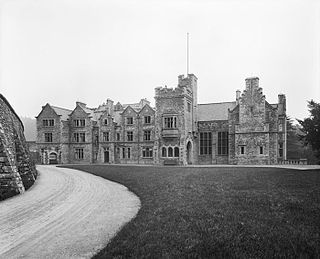
Grizedale Hall was a large country house at Grizedale, Hawkshead, in the Lake District in Cumbria, England. After two earlier Grizedale Halls had preceded, it was built anew in 1905 in the style of Gothic Revival architecture. During World War II it became No 1 Prisoner-of-war camp to hold German officers and was finally pulled down in 1957.
Coniston is a civil parish in the South Lakeland District of Cumbria, England. It contains 53 listed buildings that are recorded in the National Heritage List for England. Of these, four are listed at Grade II*, the middle of the three grades, and the others are at Grade II, the lowest grade. The parish is in the Lake District National Park and is located to the west, north and east of Coniston Water. Most of the listed buildings are houses and associated structures, farmhouses and farm buildings. The other listed buildings include bridges, a limekiln, a folly, a boundary stone, a church, a drinking fountain, and a memorial.
















